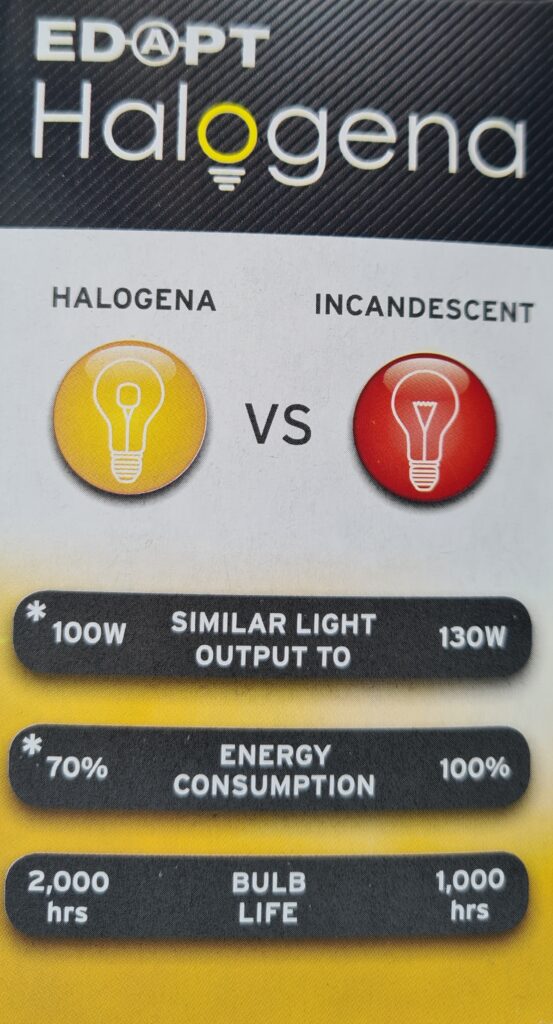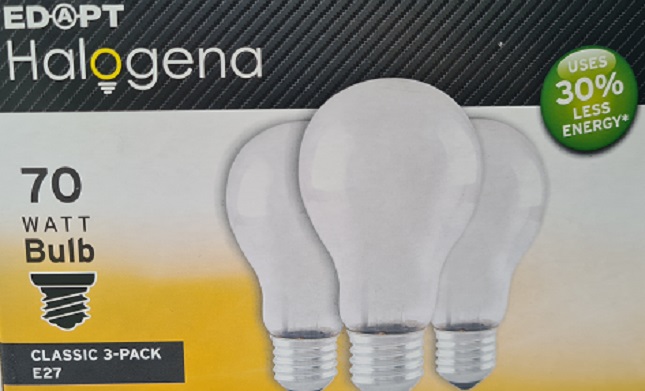
Table of Contents
Available at The Warehouse $9.00 for 3 Bulbs
70 Watt Halogena Bulb provides the same Lumens output as a 100 Watt Incandescent Bulb. (Colour Rendering Index 100).
Saves 30percent energy cost!
The halogen cycle improves efficiency
Halogen bulbs are a type of incandescent bulb, but they contain a small amount of halogen gas (such as iodine or bromine) sealed inside a compact, heat-resistant quartz envelope. This setup enables a regenerative chemical process known as the halogen cycle.
This cycle works as follows:
- Filament evaporation: Just like a standard incandescent bulb, the tungsten filament heats up and evaporates.
- Formation of tungsten halide: The evaporated tungsten atoms combine with the halogen gas to form a compound called tungsten halide.
- Filament regeneration: The gas moves toward the very hot filament. When it reaches the intense heat of the filament, the tungsten halide compound breaks apart, and the pure tungsten is redeposited back onto the filament.
- Recycling continues: The halogen gas is freed to repeat the cycle, preventing the bulb from darkening and the filament from thinning as quickly.
How the cycle increases efficiency
The halogen cycle’s regenerative properties allow for two key improvements in efficiency:
- Higher operating temperature: Because the filament is constantly being regenerated, it can be heated to a much higher temperature without breaking prematurely. This produces more visible light (a whiter, brighter light) per unit of energy consumed.
- Consistent light output: The prevention of bulb blackening means the light output remains more stable throughout the bulb’s lifespan. For the same amount of power, a halogen bulb produces more useful light than a traditional incandescent bulb.
The net result
The halogen cycle allows for higher temperatures and longer-lasting, more consistent light output, resulting in roughly 30% greater efficiency than a standard incandescent bulb. While halogen bulbs were an improvement over their predecessors, they are still far less efficient than modern LED or compact fluorescent bulbs.
Halogena is a brand name for traditional bulb shape containing a halogen capsule. A 70 watt halogena bulb produces the same lumen output as a 100 watt incandescent bulb. Will the 70 watt halogena bulb produce the same heat as the 100 watt incandescent bulb?
No, a 70-watt halogen bulb will not produce the same amount of heat as a 100-watt incandescent bulb. The wattage of a bulb directly corresponds to the amount of power it consumes, and that power is released as both light and heat.
The difference in heat output
- A 100-watt incandescent bulb: Because standard incandescent bulbs are very inefficient, roughly 90% to 95% of the 100 watts it draws is converted into heat. This means it emits 90 to 95 watts of heat energy.
- A 70-watt halogen bulb: Halogen bulbs are about 20–30% more efficient than traditional incandescents. This means a smaller portion of the power it consumes is converted to heat, but since it draws less power to begin with, the total heat produced is significantly lower. A 70-watt halogen will produce 70 watts of total energy (light and heat), which is a lower total energy output than the 100-watt incandescent.
Why wattage is key
The key point is that the rated wattage (70W vs. 100W) determines the total power consumption, which is the ultimate source of both light and heat.
- The “lumen output” or “equivalent brightness” rating on modern energy-efficient bulbs refers only to the visible light produced, not the total energy consumed.
- A 70-watt halogen can match the light output of a 100-watt incandescent because the halogen bulb’s energy is used more efficiently to create light.
- Despite its increased efficiency, the 70-watt halogen is still consuming and dissipating less overall power, and therefore, less heat.
What this means in practice
Because the 70-watt halogen produces less heat, it is often a safer and more cost-effective option.
- Fixture safety: Using a lower-wattage bulb prevents fixtures from overheating, which can be a safety concern with older or enclosed light fixtures.
The most suitable lighting for a Beauty Therapy clinic.
It is essential that a dimmable lighting solution with a “Colour Rendering Index of 100” is provided in the Beauty Therapy Clinic. The natural skin tones and colours are only achievable with Incandescent or Halogen lighting.
Only $3.00 per Halogena Bulb
This price is abut double that of an equivelant incandescent bulb, and the Halogena bulb has a life of more than double that of the Incandescent bulb.
This is an excellent replacement for the incandescent light bulb. It is fully dimmable and saves 30percent of energy costs, plus provides the essential “CRI 100” output.

